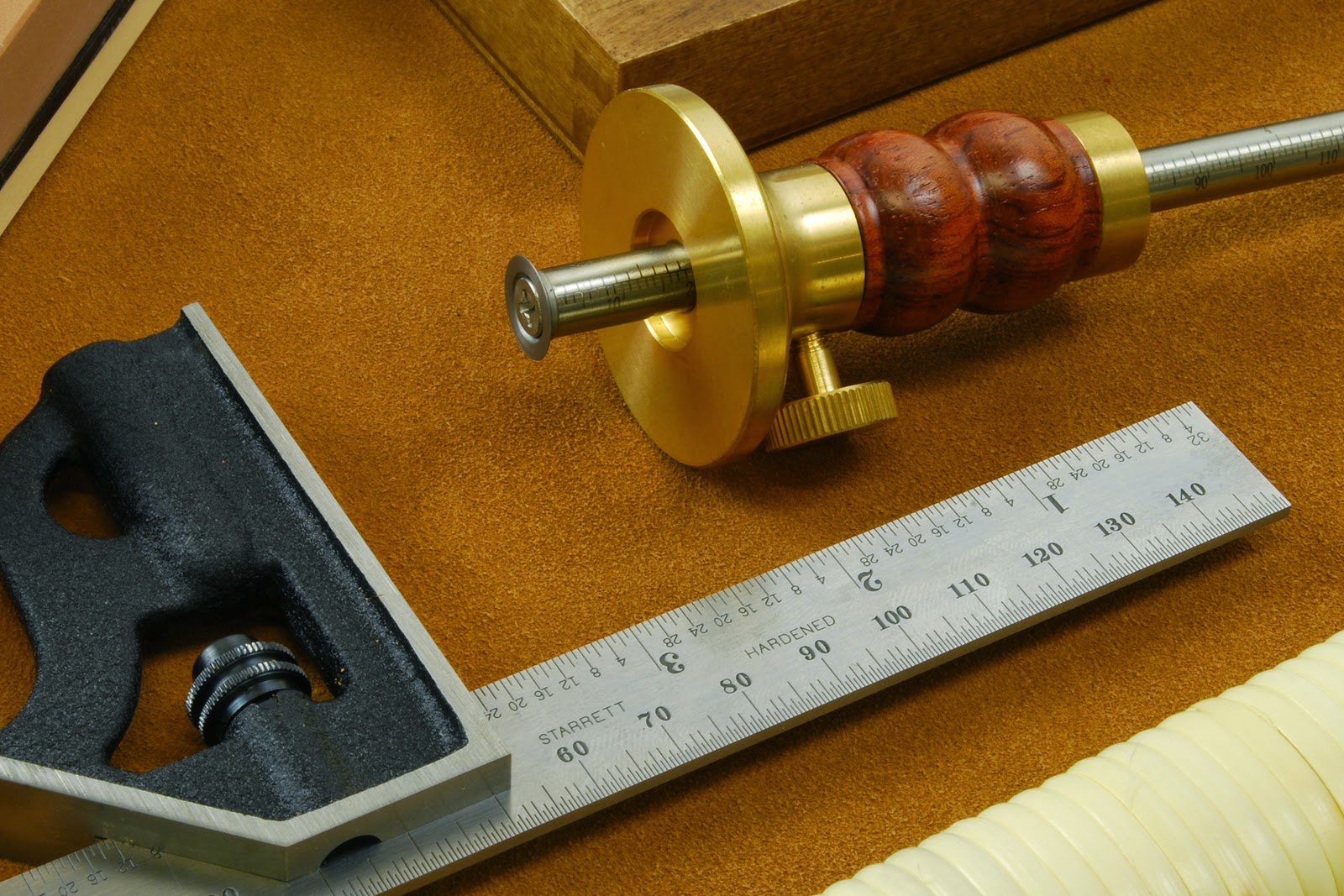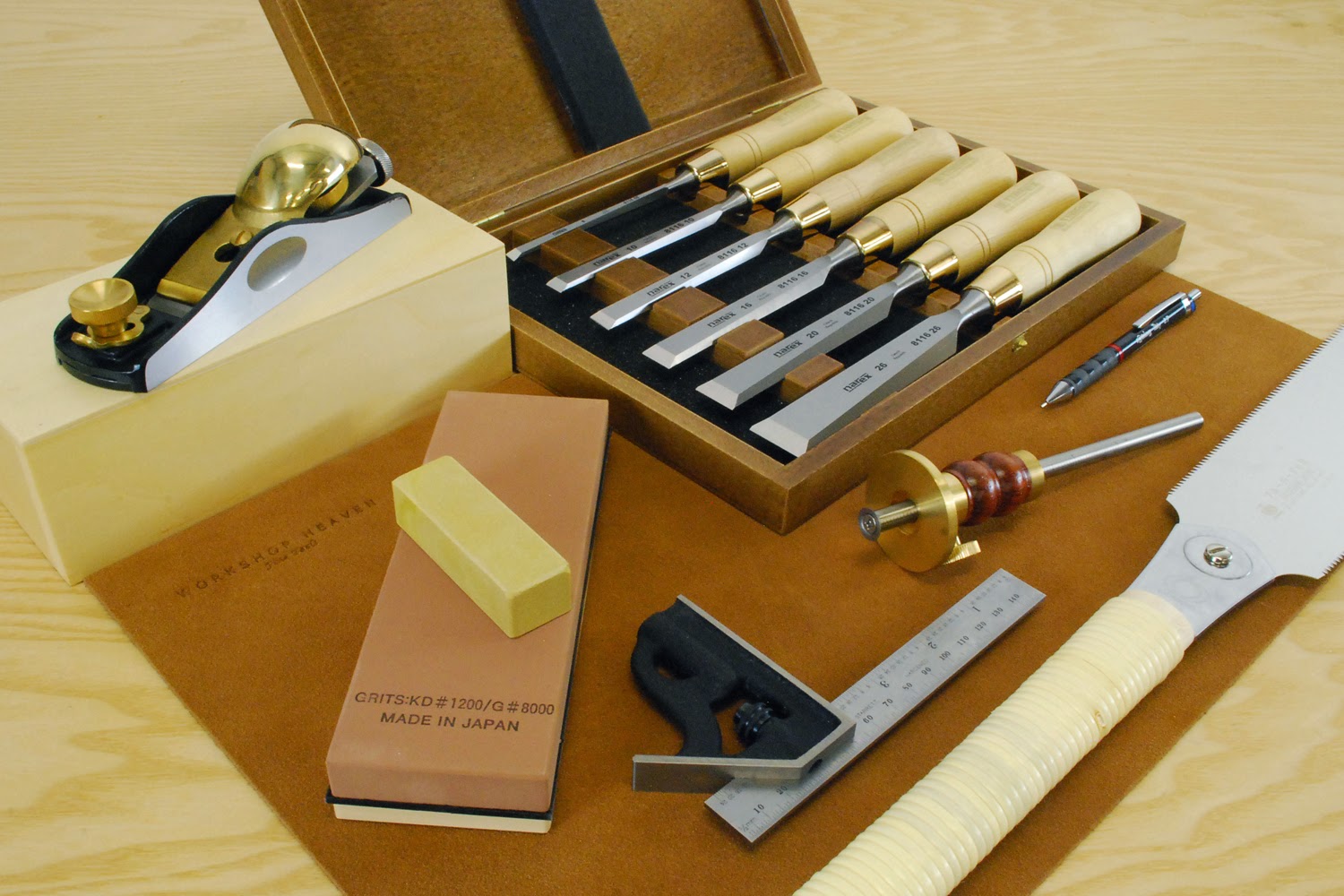Putting together a beginners tool kit for people who want to get into fine woodworking isn't as straightforward as you might first imagine. Lots of people have asked for one though, so I've had a read through several tutor's recommended tool lists, scratched my head and put together a
Workshop Heaven Fine Woodworking Starter Set.
I have intentionally avoided setting a budget and trying to work within it, as this can often lead to poor decision making. Instead I have prioritised that every pound should be invested as wisely as possible in high quality, versatile tools that won't need replacing.
There needs to be enough in the kit that you can complete some basic projects and practice pieces - getting boards flat and square, dovetailing two boards together, constructing a simple box, lap joints, finger joints, mitred joints and so on.
I have also considered that people may be working either in a college environment, or at home, or both. Of all the fine woodworking schools that we work with, I can't think of any tutors that would be disappointed to see you walking through the door with this standard of kit.
Here's a list of the tools that made the cut and why:
 |
| Click to enlarge |
Narex 8116 Cabinetmakers Chisels - Boxed Set of 6
These are the most affordable proper cabinetmakers chisels on the market, if they were twice the price they would still be a sensible purchase. The steel is good, the backs are flat, the bevels are ground close to the back giving good sightlines and access. Ours have smaller handles than standard on the 26mm and below, so they are comfortable and well balanced. The boxed set is easily transportable for those attending college, evening classes etc.
Rotring 0.7mm Propelling Pencil
A cheap item but an important one to get right, so I am throwing caution to the wind and being prescriptive. Most clutch pencils are 0.5mm, which is too thin for writing on wood, a normal wooden pencil will make a line of variable thickness depending upon when it was last sharpened. This 0.7mm rotring functions reliably, the leads are less prone to breakage and it produces a consistent line. You will probably want to add a proper marking knife at some stage, but will continue to use pencil to note face side and edge, grain direction, saw balance marks etc.
Gyokucho 651 Blue Hard Japanese Ryoba Saw
I've gone for a Japanese saw because you'd need to spend three times as much to get a western one with similar performance. The ryoba saw gives you more versatility than any other, with the rip side you can resaw a small board, make cheek cuts for tenons and bridle joints etc while the crosscut side will take care of sawing accurately to length and cutting shoulders. The crosscut side is just fine enough to bridge the gap until you can get a dedicated dovetail saw. A dovetail saw should be high on the list of things to get next, but since you can't do stock preparation very effectively with a dozuki, the ryoba made a better first choice.
 |
| Click to enlarge |
Quangsheng Marking Gauge
You need to be able to cut a gauge line with reference to a prepared edge in order to lay out joints. The wheel marking gauge produces a crisp line, whether across or with the grain can also be used as a depth gauge. This isn't the cheapest gauge in the world, but it is rock solid, easy to use and deadly accurate. Most makers end up with three or four, so the settings can be maintained throughout the project. Until you reach that stage, marking an accurately planed block of scrap each time you make a setting will enable you to revert to your previous settings.
Starrett Student Combination Square
A small square of some kind is on everyone's kit list. I've plumped for the small Starrett because it is remarkably accurate (to two thou!) versatile and affordable. The blade can be seperated and used as a rule / mini straightedge and the ends of the rule are adequately square to mark out from. The stock can be sat on the workpiece and used as a reference for chopping cuts, as well as functioning as an external 45, 90 and 135 degree square. Reassembled, the sliding square is ideal for checking joinery because you can move the unused portion of the blade out of the way. For around £40 and given the number of situations it can get you out of, it's a no brainer.
 |
| Click to enlarge |
King 1200/8000 Japanese Waterstone
Sharpening is very subjective, the reason I have gone for a combination waterstone is twofold. A combination waterstone will give you a properly sharp edge at a reasonable price, and using a waterstone teaches you more about honing than any other medium. This is a honing stone, both sides are used to prepare the small honed bevel at the tip of the chisel and polish the underside of the cutting edge. If you need to reshape a blade I would recommend either 100 micron microfinishing film stuck to a piece of float glass.
General Purpose Workshop Leather
You could get by without this, but it has so many uses that I just had to pop one in. You can use it as a strop, a vice liner, a working surface, protection for the workpiece, cut pieces off to line the jaws of clamps or holdfasts for extra grip....
Quangsheng Low Angle Block Plane (single iron)
A block plane is regarded as an essential for almost all forms of woodworking, so I have included our most popular model. Additional cutting irons are available to increase the versatility of this plane, but for the mild timbers like beech, poplar, or reclaimed mahogany that beginners should ideally be using, the single iron is sufficient to begin with.
Choosing your Bench Plane
I have intentionally avoided prescribing a bench plane in the kit, although you will need at least one. Choosing the right one is an important individual investment decision and deserves a little bit of consideration.
A
No. 5-1/2 (pictured above) is the traditional recommendation, and in most cases it is a wise choice, assuming that you are of average build and have access to some half decent machinery or pre-prepared stock.
People of slighter stature may prefer to start with the narrower, lighter
No.5 jack plane.
Those that like the idea of bevel-up planes might choose a
No.62 low angle jack plane.
Some will prefer to go for a longer
No.6 fore plane and one of the
smoothing planes - perhaps a better combination if your boards have more than a mm or two of cup, wind or twist.
Whichever planes you choose, we have included a discount code in the kit that gives you the same discount on any other items (not just planes) that you purchase in the same transaction.
Suggested Additions
The following is a non-exhaustive list of other tools that might make logical additions to your tool kit, if anyone has any suggestions for things that could be included, please add a comment at the bottom of the page.
For sawing the waste out of through dovetails rather than chopping it. For dovetailing I recommend either the
No.5 DPR blades for thinner material and the
No.9R Reverse Skip for thicker stock. Stretching to reach the bottom rung of the Knew Concepts ladder is a better investment than the steel framed saws. If you can get the lever tension version, so much the better.
Marking out with a knife defines a clean shoulder that is then preserved as you chisel back to it. If your intact knifed layout line IS the end of the finished component, there can have been no loss of accuracy in the making process. The left and right bevelled knives are to allow you to work comfortably off a reference surface to the left or right, not whether you are left or right handed.
A honing guide allows you to repeat the exact position of the blade and re-polish the existing secondary bevel in a few light strokes. They save time, steel, stone and frustration. Richard's guides are designed with respect for the relevant engineering concepts (referencing off the back of the blade only, wheels outboard of the blade so the guide dictates square to the edge) and manufactured with great precision. The No.2 guide is easy to get on with and can accommodate all parallel sided blades you are likely to encounter.
Japanese saws are easy to learn with and produce accurate results with very little effort. If you are used to using a western saw they may take a few cuts to get used to. The scalpel-like precision of a dozuki makes it possible to saw within a couple of shavings of a knife line. The 303 is optimised for 12mm stock (+/- 6mm), if your material is typically thinner than that, then the
311 Sun Child might be a better option.
A small hammer or mallet for making chopping cuts. For fine work the most aggressive we tend to get is pinching the neck of the chisel between finger and thumb and lightly tapping the top. A medium weight round carvers mallet or chisel hammer are the ideal tools for the job.
If you want to work to a tenth of a mm, it is important to be able to measure to a hundredth. Cheap calipers are awful - you are honestly better off with a good rule and a bright light. The one I'd recommend without a moment's hesitation is the Kinex Absolute Zero, this instrument is about twice the price of the really cheap inaccurate ones, but it has the reliability and performance that you'd normally only find on calipers at twice the price.
I'm already thinking that we should offer a choice of the metric or imperial versions of the Starrett square, but if anyone can think of any additions to the list of supplementary tools, or other options that we could add to switch out items within the kit itself, please let me know.


















